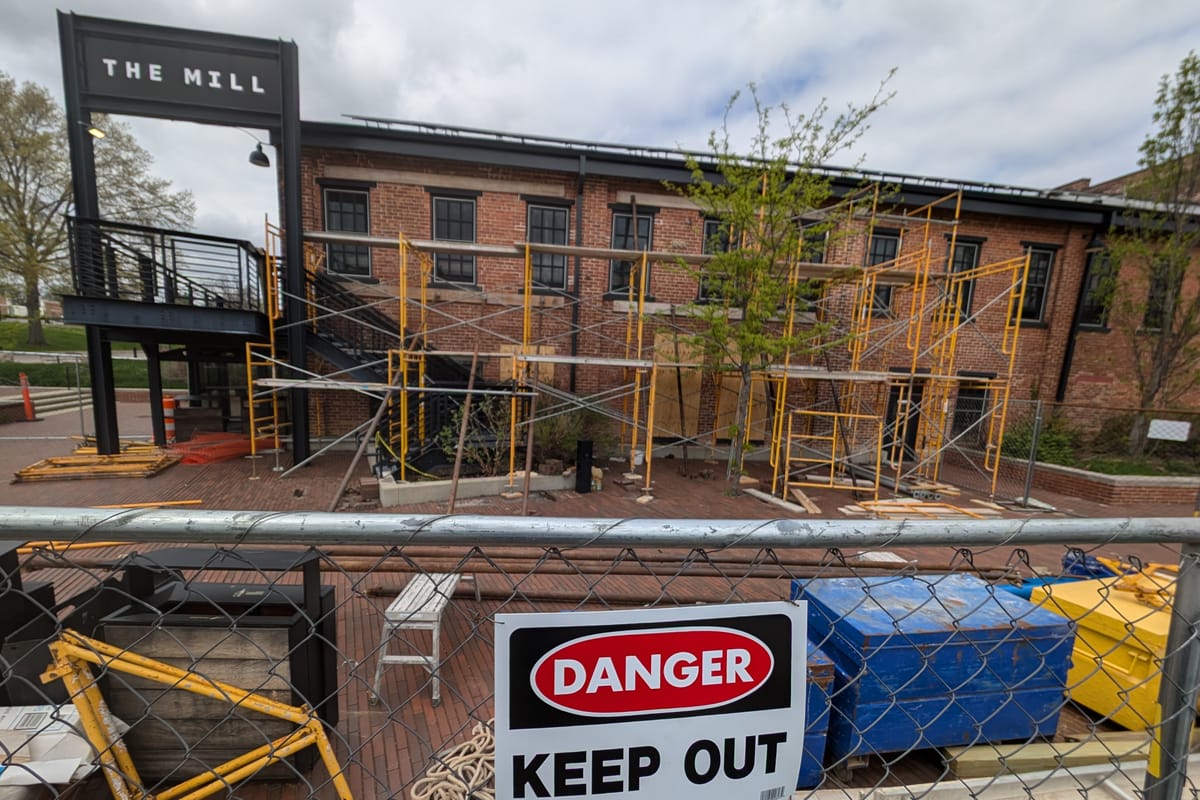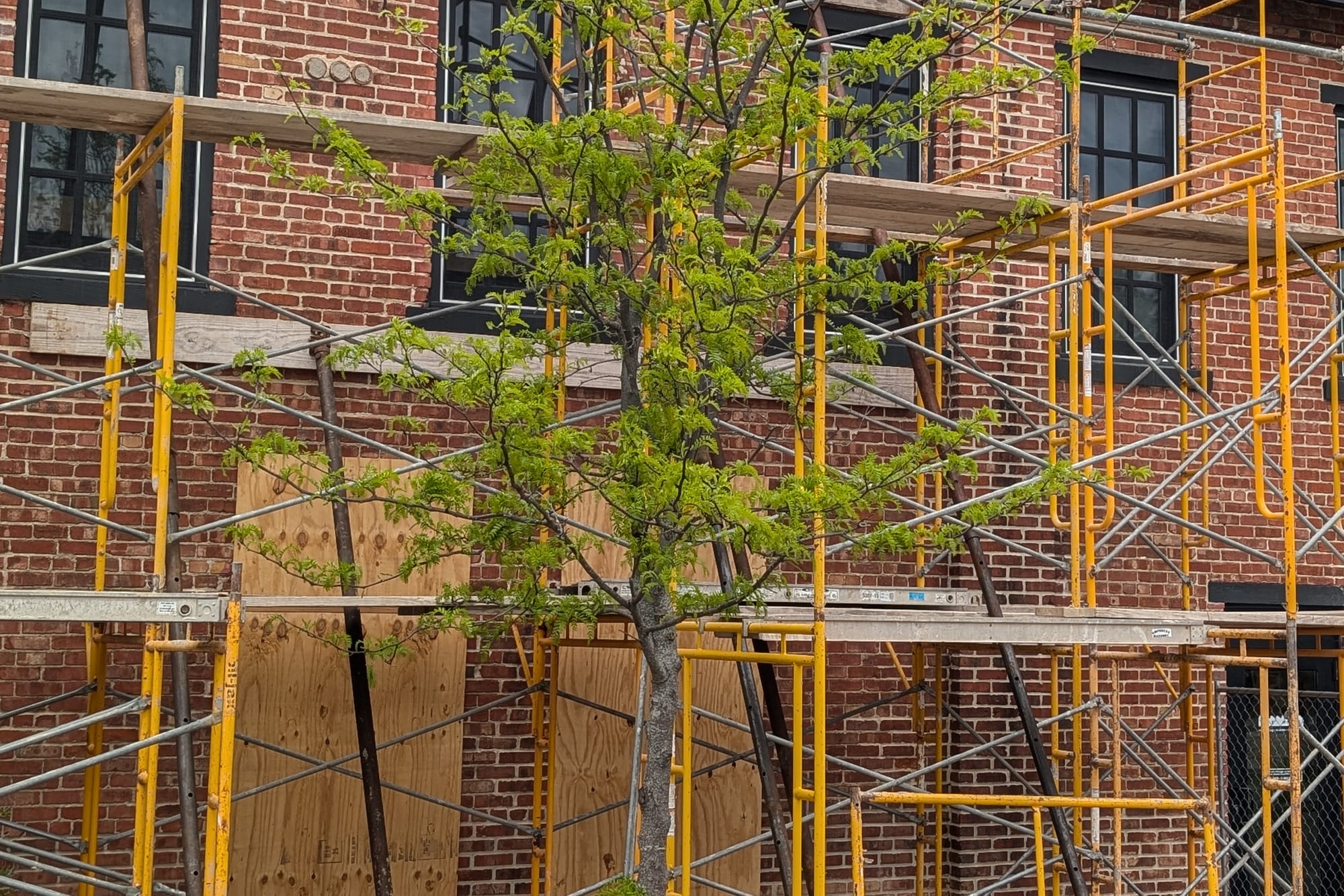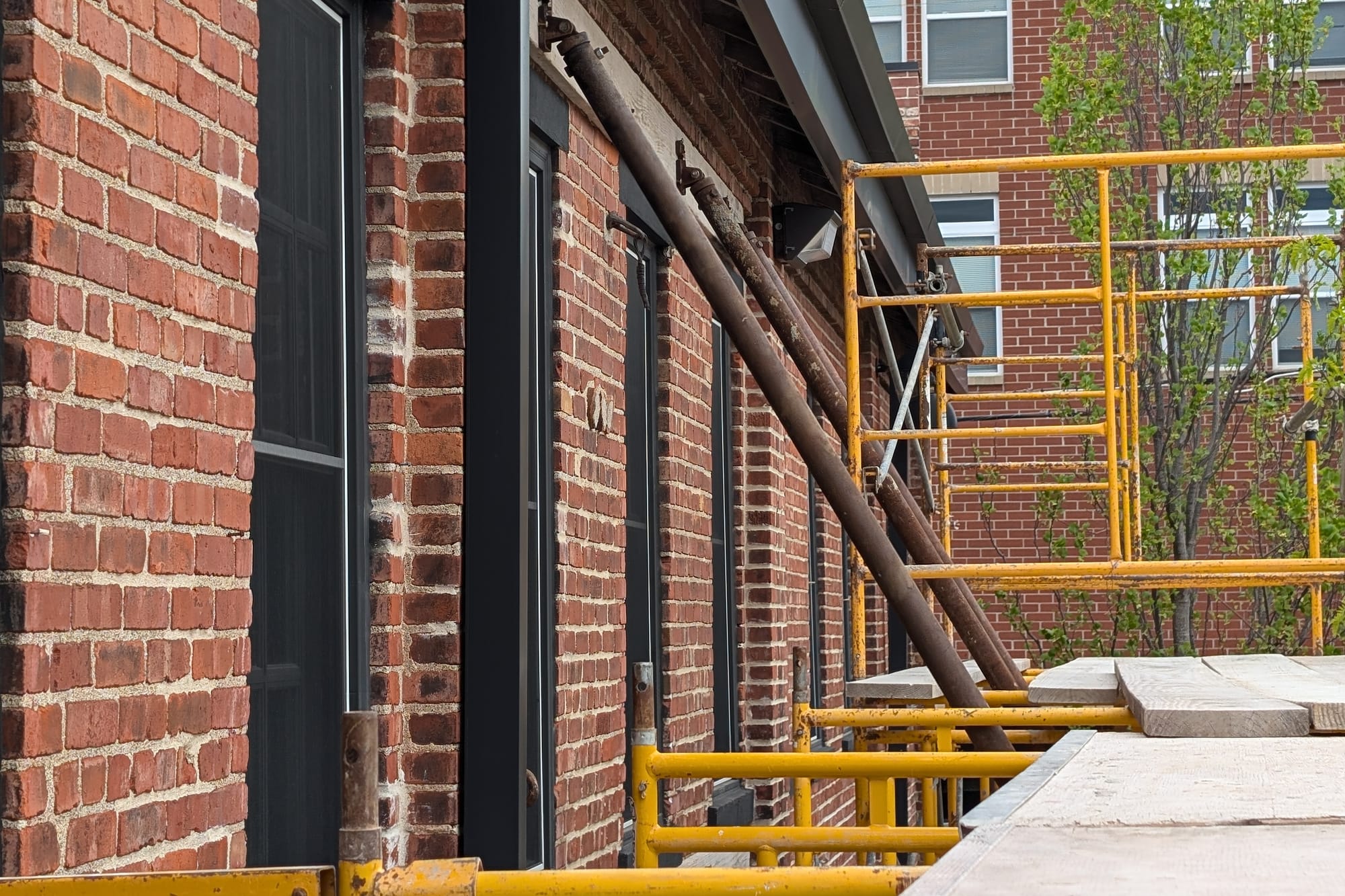Cost for shoring, repair of century-old brick wall in Trades District could reach $600K

It could cost up to a half million dollars to permanently repair the south brick wall of the former Showers Brothers Furniture building that houses The Mill in Bloomington's Trades District. The half million comes on top of the roughly $100,000 it already took to shore up the wall on a temporary basis.
That's the news from the regular Monday (April 21) meeting of Bloomington's redevelopment commission (RDC), which owns the 110-year-old building.
At the RDC's previous meeting two weeks ago, HAND (Housing and Neighborhood Development) director Anna Killion-Hanson alerted commissioners to the evolving situation with the south wall at The Mill. It was discovered to be 4.5 inches out of plumb, with mortar that was no longer binding the bricks together.
At its Monday meeting, the RDC took action on two items related to the crumbling wall—one of them to approve $106,000 for work that had already been done to shore up the wall on an emergency basis. Umphress Masonry, Inc., Belcher Fencing, and Koorsen Fire & Security did the work.
According to an April 16 memo from Bloomington operations and facilities director J.D. Boruff—to deputy mayor Gretchen Knapp and other key department heads—by mid-April the wall had been stabilized. The scope of work and timeline for the project was developed with Umphress Masonry and John Crane, with BFW Crane, Inc.
On Monday, the other agenda item related to the failing wall at The Mill was for the RDC to approve up to $500,000 for Umphress Masonry to undertake the permanent repair of the wall.
Boruff's April 16 memo says the estimate of a half million dollars is meant to be sure to cover the whole cost. He wrote: "We purposely estimated these numbers on the high side so we would not have a large number of change orders and contract amendments." Boruff's memo continues: "That being said, this is a [very] old building. There may still be some hidden issues that are discovered when the wall is deconstructed that will raise costs and extend the timeline."
Boruff said at Monday's meeting that the permanent repair will involve deconstructing about a third of the wall—from the top of the wall to the top of the first floor windows. The same brick will be used so that the wall will look the same as it always did. Boruff noted that there's an item on the agenda for Bloomington's historic preservation commission this Thursday (April 24) asking for a certificate of appropriateness for the work.
The work will take about 12 weeks, Boruff said. He indicated that the event space at The Mill won't be usable during the reconstruction work.
The old brick building houses the nonprofit that operates The Mill, which is a coworking space that opened in 2018, and describes itself as "the heart of Bloomington's startup ecosystem." In addition to generating revenue from coworking memberships, The Mill gets some revenue from outside rental of its event space, which is next to the failing wall. As Boruff pointed out, the event space next to the wall is temporarily shut down.
Two weeks ago, head of operations for The Mill, Victoria Crawley, told The B Square that The Mill had already lost an estimated $10,000 in event rental revenue. At Monday's RDC meeting, interim president of The Mill, John Fernandez pegged lost revenue from event space rentals at $50,000.
Based on its nonprofit filing for 2023, of the roughly $1.9 million in revenue that The Mill saw that year, about $106,000 of it came from rentals of non-member event space.
The issue with the wall was first noticed by staff at The Mill, according to Mill operations head, Victoria Crawley.
It was John Crane, with BFW Crane, who made the recommendation for the way the wall should be repaired. In an initial memo dated April 4, Crane gave a recommendation that the wall be "disassembled and reconstructed in entirety."
Crane's recommendation was based on the fact that the wall is 4.5 inches out of plumb.
According to Crane's memo, for a wall to be stable, the compressive forces that are bearing down need to stay within the central one-third area of the wall's thickness. For a 12-inch thick wall, the central one-third would be the middle 4 inches. Because the top part of the wall is leaning by 4.5 inches, the center of the compressive force is outside the crucial central one-third area.
At the RDC's Monday meeting, RDC member John West wanted to know if it's known what caused the wall to lean.
Boruff indicated that it's just not possible to know for sure. He did say that during the remodelling of the building, for its eventual opening as a coworking space in 2018, there was an interior frame wall that was attached to the exterior wall that was removed. Boruff also said that a portion of flooring near the wall was removed, which might have contributed to some movement in the wall, but added, "We have no way to tell for sure."
The Mill opened at the end of October 2018. Based on the materials in the RDC's Feb. 19, 2018 meeting information packet, the RDC's adaptive reuse project for The Mill totaled about $5.3 million. Just the construction on The Mill came to $4,484,419. That total broke down like this: Neidigh Construction ($2,763,000); HFI ($796,900); Ryan Fire Protection ($75,360); and Cassady Electric ($522,570). Additionally, $1,839.64 was allocated for a security system, $249,750 for construction management, and $75,000 for contingency.


The Mill, looking north and east at the failing south wall, which is shored up with braces. (April 21, 2025)




Comments ()